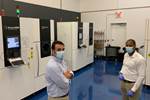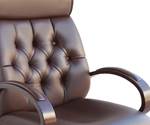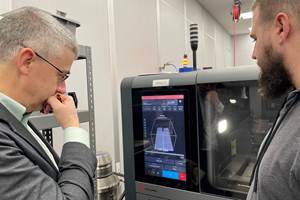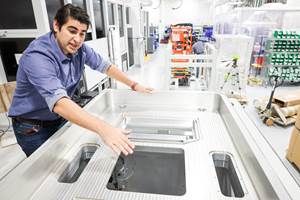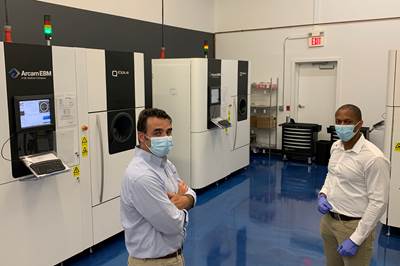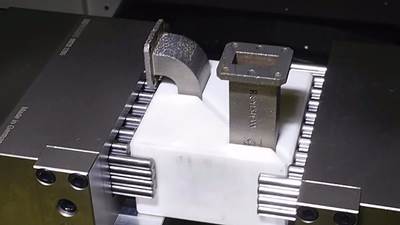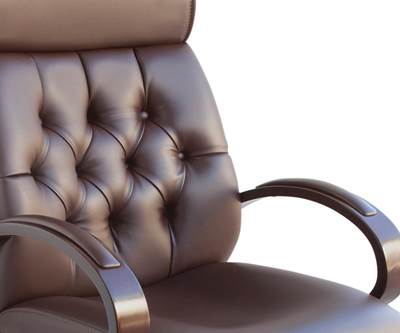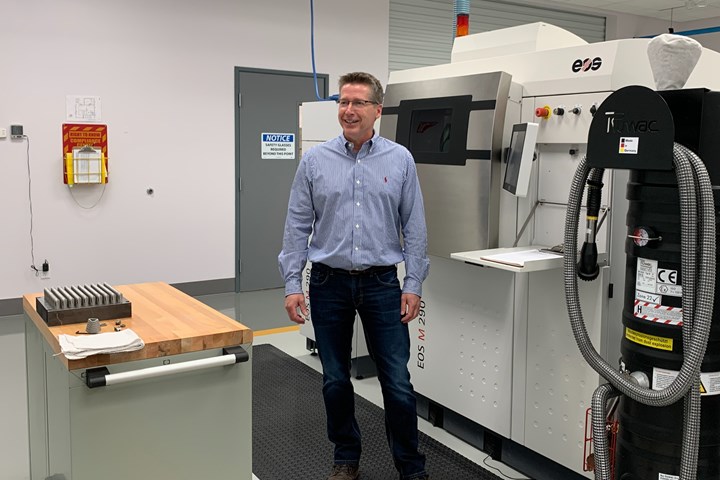
Toby Farling does his best to win work for additive manufacturing with every new project that comes to Paragon Medical, and he doesn't always succeed because machining has wins, too. He now uses AM for prototyping and process development within a facility that applies machining capability for the same purpose as well. Read more in the article below.
To make the fullest use of additive manufacturing (AM) and CNC machining within the same organization, let them compete with one another.

This is the door into cutting. Additive and machining are this close together; this view looks past one of the metal AM machines and into the CNC machine shop.
Paragon Medical, part of MW Life Sciences, has been discovering the value of this simple idea. The Indiana-based contract manufacturer of medical instruments, implants and other medical devices recently established what it now calls its “MW Innovation” facility by bringing the machining capability for new product prototyping and process development into the same Warsaw, Indiana, building as its metal AM capability devoted to this same purpose.
Which of these options is best? For any given new product, is it additive or is it a traditional, strictly subtractive part-making process that offers the most effective option for product development and the right path through prototyping and into production? The answer is not always clear.
Sometimes a customer anticipates one course without realizing the other might save cost. Sometimes Paragon’s first guess is not the best approach, because the part that seemed to lend itself to machining can be made quite well through 3D printing or vice versa. For these reasons, there is no single person or single early moment within MW Innovation for making the sole, standing determination for which processing path a new product or part family will follow. The choice is too important for that.
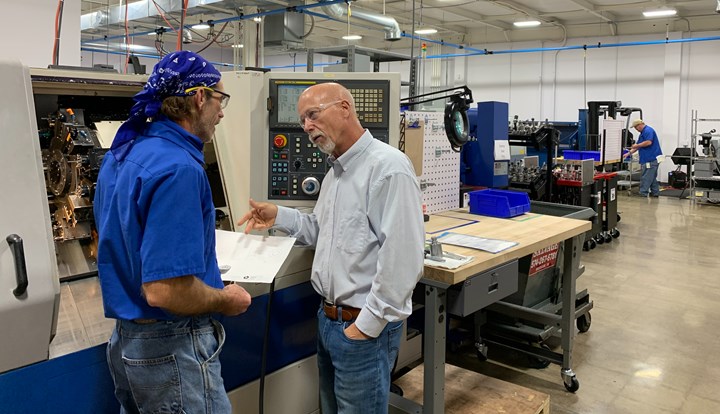
Dan Owens (right) leads MW Innovation. A Paragon employee nearly since the company’s founding, he also led the effort to relocate prototype machining out of a production machining facility and into a space shared with additive.
Instead, MW Innovation’s team of 10 includes both a machining leader and an additive leader. Both are experts and advocates for their technologies. Both routinely work together, because a part made additively generally requires at least some machining. But both also compete. Paragon frequently finds the best method for a new prototype by having each of these champions propose the best plan they can for producing the product or part. Which approach is more cost-effective can be surprising, plus cost alone frequently is not the primary consideration.
Prototyping as a Priority
In medical instrument and implant manufacturing, prototyping, along with the product development stage, represents a more meaningful part of the path to production than in other industries and product types. For a consumer product, the prototype might be 3D printed no matter how it will eventually be produced, and the prototype might face relatively few hurdles. For a medical product, the requirements to validate the product and in some cases the process itself are so rigorous that prototyping and process development represent long and costly steps, and may involve full development of the production method well before production begins. Therefore, when the machining lead and the additive lead at MW Innovation find themselves in friendly competition for a new prototype, they are doing something other than contesting with one another for the bragging rights of winning the work. They are testing and challenging one another to ensure Paragon is proposing the very best course for successfully developing the product, with the best hope for Paragon to get to perform that product’s production in the end when the product development is done.
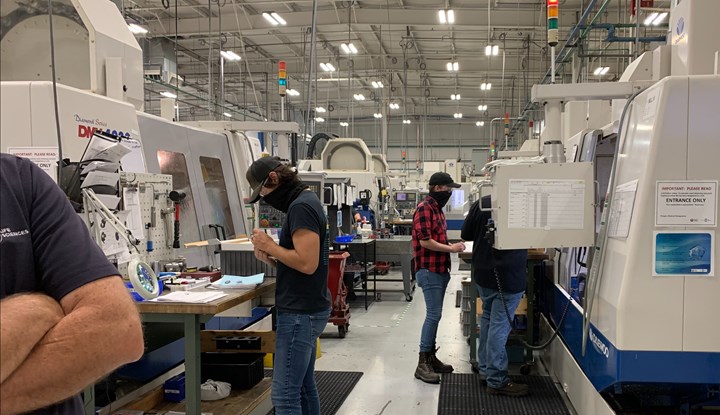
Machining capability in the MW Innovation facility is similar to what is used in production. This is a view of production machining in a different facility, in Pierceton, Indiana. Prototyping and process development are performed on similar machines...

... as this view of MW Innovation shows.
So far, only machining has been used for full-scale production, at least within Paragon’s own facilities. (Some additive production has been outsourced.) Machining is of course the production capability the company has used since the beginning, while metal AM capability is relatively new. However, additive will not remain just a prototyping process for Paragon. Indeed, one of the process’s distinctive benefits is the extent to which prototyping in AM essentially is production. Unlike machining, the exact process that succeeds for prototyping an AM part can easily and immediately be scaled up into production work if there are more available AM machines to do it. For this reason, new additive machines intended for production capacity are likely to be installed in Warsaw, at the MW Innovation site. There are two EOS laser powder bed fusion metal AM machines here now, with easily enough floorspace for four more.
Toby Farling is the MW Innovation’s additive manufacturing manager. The labor input of AM is slight enough that overseeing six machines would not be much more demanding than overseeing two. His counterpart, toolroom manager Jason Wood, is the site’s machining champion. They both report to Dan Owens, VP of innovation and technology, who oversees MW Innovation and who also arguably launched it into existence when he proposed relocating prototype machining to this site. As Owens describes it, unlike AM, the better choice for prototype machining is to keep it and production far apart.
Protect the Future
Paragon Medical began in 1991 when a small machine shop reinvented itself to focus strictly on medical products. The considerable growth since then has come both organically and through acquisition — both acquiring and being acquired, most recently by MW Industries — so that this business unit today employs 1,300 and includes seven manufacturing facilities in the U.S. plus one each in Asia and Europe. Both Toby Farling and the metal AM capability came as a result of acquisition; they were part of a company that bought Paragon (an earlier owner), adding this AM expertise to Paragon’s considerable machining capability. The building came this way also, and Owens took note.
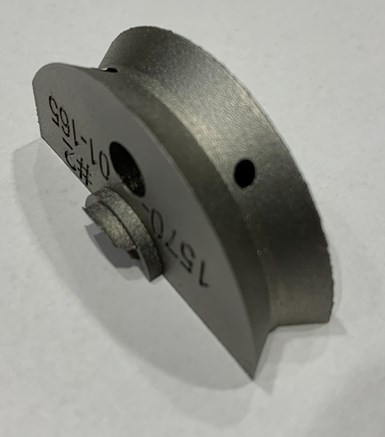
Machine or 3D print? The customer felt the part could be made more cost-effectively through 3D printing. Paragon discovered the customer was right.
The prototype machining department that Owens oversaw at that time was located within an instrument and implant production facility in Pierceton, Indiana, a plant with about 140 CNC machine tools. His prototyping department was no mere toolroom (even though it was called that), but instead, just as it does now, it had CNC machining technology at the same level as that used in production, certified for medical part making. And therein lay the problem.
“Because we were in the production facility, we were the obvious answer whenever there was a production overflow. Our capacity would get gobbled up by production,” Owens says.
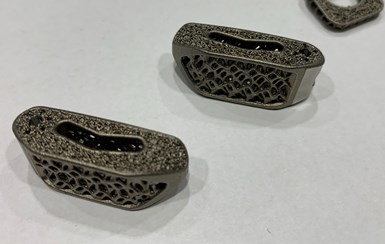
Spinal implants are an example of a product developed via AM that has moved into full production via AM. Right now, this production is outsourced. Paragon will be adding AM capacity internally that is dedicated to production.
The quick fix imperiled the future. The company needed to remain committed to prototyping as a means of pursuing production work to come. The production in the present had a way of consuming that future. All could see this, but it was a hard habit to break. Owens decided to investigate getting away.
“I went to the building where we were doing 3D printing. I saw the additive machines there, but then there was all this extra space used for storage.” He proposed a reframing of where to locate capacity: Instead of additive and machining being in separate facilities, what about prototyping and production being separated?
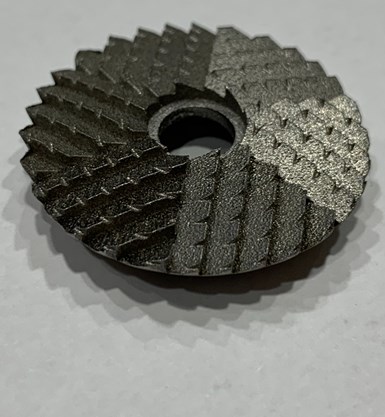
Do metal AM parts need machining? Usually yes. Not in this case. For this cadaver tool, additive alone achieved the needed edge sharpness.
He picked a good moment. The Pierceton plant need floorspace to expand its number of horizontal machining centers. Among other parts, these machines are used to produce surgical cutting guides for knee replacement surgery, parts as geometrically complex as the knee implants themselves with similar need for precision. Company leaders wanted to increase the number of these machines (from Makino) from six to 10, and add more shopfloor coordinate measuring machines to support them. Owens’ volunteering to relocate prototyping was a big step toward freeing up enough room. His idea thus not only protected prototyping but also enabled production to expand.

This surgical measuring device would seem to be a poor candidate for 3D printing. The precision required calls for machining. However, 3D printing potentially saves cost by turning weldments into solid parts. The path to production for this product might ultimately involve machining and 3D printing in equal measure.
It also ultimately brought about a new prototyping and product development culture within Paragon in which AM and machining interrelate, influencing and spurring one another. Having the capabilities together teaches everyone involved with them, Owens not the least of them, what each capability can do. The friendly competition between processes grew organically out of this interaction. Farling, the AM champion, says the proximity — not separation — is what makes this competition effective.
“With some parts, all that matters is the holes,” he says. These parts can be 3D printed, but hole tolerances are so fine that these features must be machined. Thus, while 3D printing is the answer and perhaps the winning process, 3D printing alone cannot get there. And in machining, 3D printing offers new options for tooling. In short, while the processes compete, the competitor might also be an enabler. This interaction has sped the development of Paragon’s understanding of how and where additive can best be used.
Instruments and Implants
There have been surprises. For a component of a medical robot that Paragon would have been ready and able to machine, the customer asked if it would be feasible and perhaps even cheaper to have it 3D printed. “The customer was right,” Owens says. Additive plus minimal machining proved to be an effective approach. Another part demonstrated that while the need for machining is typical of AM parts, it is not universal. A cutting tool for cadavers was 3D printed to the necessary edge sharpness — no machining of the edges was needed.

Which parts are 3D printed and which are machined? In this photo, all are printed. Additive manufacturing is not always the answer, but it is an alternative to conventional processes providing Paragon and its customers more paths forward than ever before.
Owens says, in general, AM is a fit for implants and machining is more apt for medical instruments. Implants benefit from additive because their shapes are complex and because surface roughness is often beneficial. Implants are also the faster-growing part of Paragon’s business — the company is already producing spinal implants additively at the rate of 3,000 per month by using a supplier for this work.
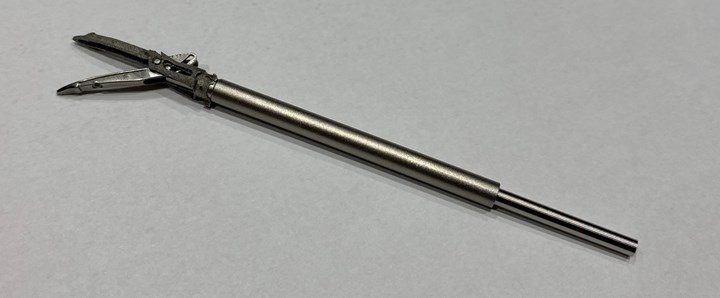
Robotic end effectors are a market opportunity that Paragon is ready to grab. AM allows the company to create designs quickly and go to production quickly if need be. Machining might be cheaper, but the engineering and tooling time for developing a machining process introduces delay.
But the role for AM with instruments is large as well. The need here often relates to speed to market. The competition between machining and 3D printing at MW Innovation is sometimes over cost, but more frequently over time. The path to production thus might involve AM for both the prototyping and early production, while the machining process is developed, programmed, and tooled for use after the product has fully arrived. For Paragon right now, perhaps nowhere is this advantage of AM more apparent than in end effectors for surgical robots. This market is growing so quickly that it is important to be able to 3D print end effectors so they are available for production now, even though CNC machining will provide more cost-effective production later, after the lead time needed for engineering the machining process.
This last point, the need to develop products quickly by helping customers innovate quickly and move to production quickly, highlights why sophisticated prototyping and process development is so valuable to Paragon, and why AM makes this capability more valuable still. As the natural next step, production AM is coming; it is coming to this very facility. Plans are begin discussed for this. But Farling and Owens say they have learned a lesson from machining; they know how to protect the prototyping capacity once AM production comes. When Paragon begins to develop its own internal capacity for production metal additive manufacturing, they say they intend to propose keeping two of the machines deliberately uncertified for medical production so the capacity is not available to be taken away from prototyping.
Related Content
Additive Manufacturing Is Subtractive, Too: How CNC Machining Integrates With AM (Includes Video)
For Keselowski Advanced Manufacturing, succeeding with laser powder bed fusion as a production process means developing a machine shop that is responsive to, and moves at the pacing of, metal 3D printing.
Read MoreFreeform: Binder Jetting Does Not Change the Basics of Manufacturing
Rather than adapting production methodologies to additive manufacturing, this Pennsylvania contract manufacturer adapts AM to production methodologies. In general, this starts with conversation.
Read MoreSeurat: Speed Is How AM Competes Against Machining, Casting, Forging
“We don’t ask for DFAM first,” says CEO. A new Boston-area additive manufacturing factory will deliver high-volume metal part production at unit costs beating conventional processes.
Read More3D Printed Lattice for Mars Sample Return Crash Landing: The Cool Parts Show Bonus
NASA Jet Propulsion Laboratory employs laser powder bed fusion additive manufacturing plus chemical etching to create strong, lightweight lattice structures optimized to protect rock samples from Mars during their violent arrival on earth.
Read MoreRead Next
For EBM Implant Manufacturer, Growth Is Built into the Plan
Amplify Additive needs to be small today. A close, nimble team can innovate quickly and realize the promise of additive manufacturing for orthopedic implants. Yet the company needs to be bigger soon, because success will lead to scalable production.
Read MoreMeeting the Machining Challenges of Additive Manufacturing
You can 3D print the part, but can you finish it? Here is how to overcome the challenge of part deflection in the machining of lightweight, complex AM parts.
Read MoreWhat Your CEO Needs to Know About Additive Manufacturing
Additive manufacturing promises to affect far more than manufacturing alone. When evaluating AM, the perspective needed is the view that sees the impacts all across the enterprise.
Read More


